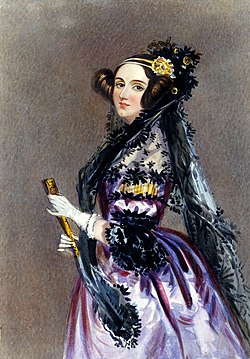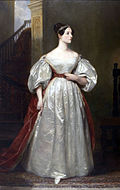Ada Lovelace
Ada Lovelace (10 December 1815 – 27 November 1852) was an English mathematician and writer. She is known as the first computer programmer.
Ada Lovelace | |
|---|---|
 | |
| Born | 10 December 1815 London, England |
| Died | 27 November 1852 (aged 36) Marylebone, London, England |
| Nationality | British |
| Scientific career | |
| Fields | Mathematics, computing |
Achievements
Lovelace wrote the first computer program in 1844. It was for Charles Babbage's machine, the "Analytical Engine". This machine was never built, but her program was the first algorithm made for a computer.
Between 1842 and 1843, she translated an article by Italian mathematician Luigi Menabrea. She added notes with her own ideas. These notes included the first computer program. Her work is important in the early history of computers.[1]
She understood that computers could do more than just math. Others, like Babbage, thought computers could only do calculations.[2][3]
Childhood
Ada was born on 10 December 1815. Her parents were Lord Byron, a famous poet, and Anne Isabella Milbanke. Her parents separated soon after she was born. She never knew her father. Her mother was an aristocrat and gave Ada a good education at home. She became interested in mathematics, partly because of Babbage.[4]
Later life
In 1835, Lovelace married William King. They had three children. She got cholera, but survived. She also had asthma and stomach problems. She took strong painkillers, which led to an addiction to opium. She died of uterine cancer in London on 27 November 1852.
Recognition
The U.S. Department of Defense named Ada (programming language) in her honor.
Ada Lovelace Media
Ada Byron, aged seven, by Alfred d'Orsay, 1822, Somerville College, Oxford
Sonnet titled The Rainbow in Lovelace's own hand (Somerville College)
Painting of Lovelace seated at a piano, by Henry Phillips (1852). Although in great pain at the time, she agreed to sit for the painting as her father, Lord Byron, had been painted by Phillips' father, Thomas Phillips.
Portrait of Ada Lovelace by the British painter Margaret Sarah Carpenter (1836)
References
- ↑ Essinger, James 2014, Ada's algorithm: how Lord Byron's daughter Ada Lovelace launched the digital age, Melville House Publishing, ISBN 978-1-61219-408-0
- ↑ Fuegi J. & Francis J. 2003. Lovelace & Babbage and the creation of the 1843 'notes'. Annals of the History of Computing, 25 (4): 16–26. [1]
- ↑ Schlager, Neil and Lauer, Josh (eds) 2001. Emergence of women at the highest levels of mathematics. In Science and Its Times, vol. 6, Gale.
- ↑ Spicer, Dag. "Lovelace, Ada." World Book Advanced, World Book, 2017.
Other websites
| Wikimedia Commons has media related to Lua error in Module:Commons_link at line 62: attempt to index field 'wikibase' (a nil value).. |
- Women in science. [2] Archived 2018-12-25 at the Wayback Machine
- Ada Byron, Lady Lovelace. [3]








